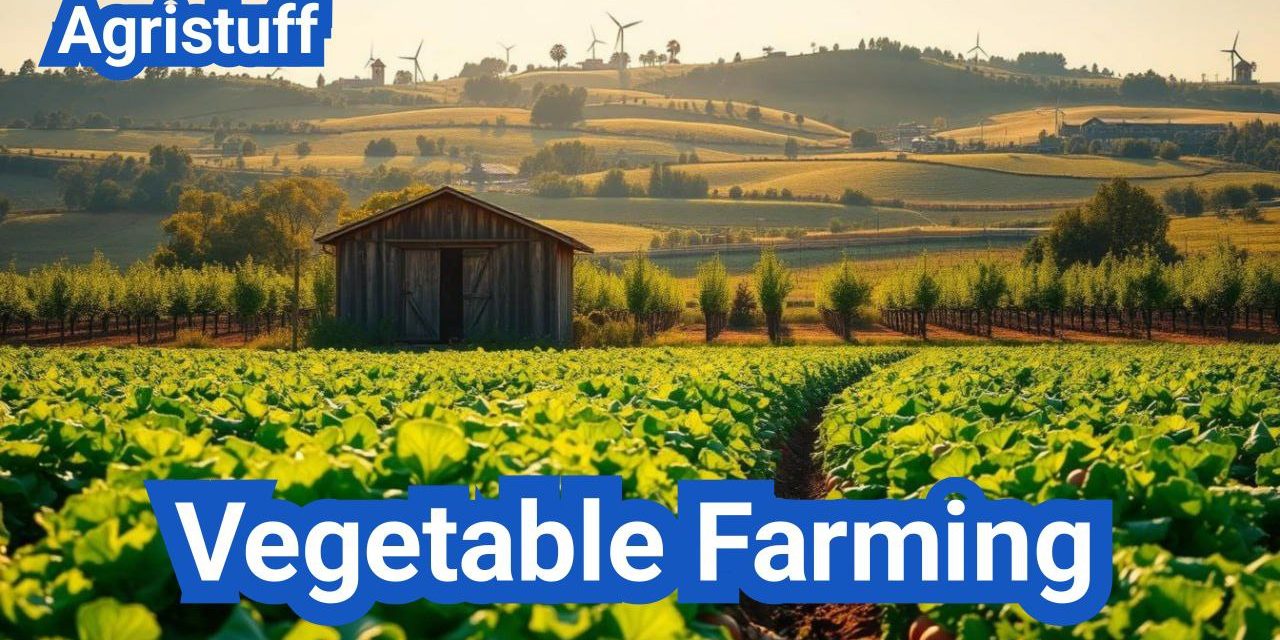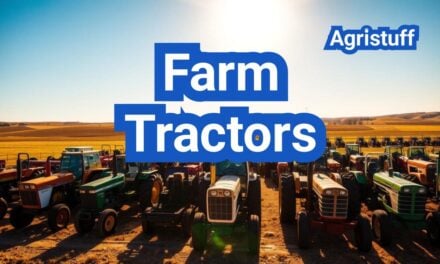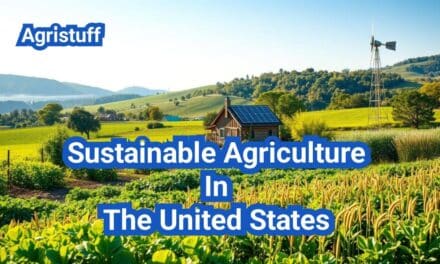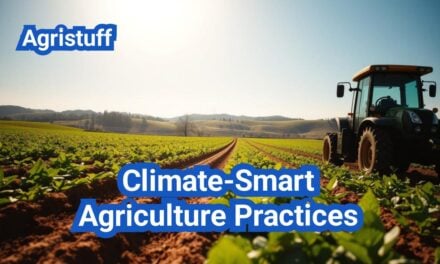Starting a vegetable farming business requires careful planning, preparation, and execution. According to The Old Farmer’s Almanac, the key to a successful harvest lies in planning, preparing the soil, and choosing the right crops.
Effective planning involves selecting the right vegetables for your climate and soil type. Agriculture of vegetables is a nuanced process that demands attention to detail and a thorough understanding of the local ecosystem.
A well-prepared soil is crucial for a bountiful harvest. This involves testing the soil type, adjusting its pH level, and adding necessary nutrients. By understanding the basics of veg farming, you can create a thriving vegetable farming business.
Key Takeaways
- Careful planning is essential for a successful vegetable farming business.
- Soil preparation is crucial for a bountiful harvest.
- Choosing the right vegetables for your climate and soil type is vital.
- Understanding the local ecosystem is necessary for effective agriculture of vegetables.
- A well-prepared soil is key to a thriving veg farming business.
The Fundamentals of Vegetable Farming
Understanding the fundamentals of vegetable farming is essential for both small-scale gardeners and large commercial farmers. Vegetable farming is a complex process that involves more than just planting seeds and waiting for them to grow. It requires a deep understanding of the soil, climate, and various farming techniques.
What Defines Vegetable Cultivation
Vegetable cultivation refers to the process of growing vegetables for human consumption. It involves selecting the right varieties, preparing the soil, planting, maintaining, and harvesting crops. Efficient vegetable cultivation is crucial for ensuring food security and meeting the nutritional needs of a growing population.
The choice of location is critical for successful vegetable farming. A site with full sun and well-drained soil is ideal for most vegetable crops. This is because vegetables generally require a lot of sunlight to grow and well-drained soil to prevent waterlogged conditions that can lead to root rot and other diseases.
The Economic and Nutritional Importance
Vegetable farming is not only a source of nutrition but also an important economic activity. It provides income for farmers and employment opportunities in rural areas. The economic importance of vegetable farming is further underscored by its contribution to the GDP of many countries.
From a nutritional standpoint, vegetables are a vital part of a healthy diet, providing essential vitamins, minerals, and fiber. They are crucial for preventing chronic diseases such as heart disease, diabetes, and certain cancers. Diverse vegetable production ensures a wide range of nutrients are available to consumers.
Evolution of Modern Farming Practices
Modern vegetable farming has evolved significantly, incorporating new technologies and practices to improve efficiency and sustainability. Techniques such as precision agriculture, drip irrigation, and integrated pest management have transformed the way vegetables are grown.
These modern farming practices not only enhance productivity but also contribute to sustainable farming by reducing the environmental impact of farming activities. As the global population continues to grow, the adoption of such practices will be crucial for ensuring food security while minimizing the ecological footprint of agriculture.
Planning Your Vegetable Farm

Planning your vegetable farm is a multifaceted process that involves assessing your resources and setting clear objectives. This foundational step is crucial for the success and sustainability of your farming venture.
Assessing Your Land and Resources
The first step in planning your vegetable farm is to assess your land and available resources. This includes evaluating the quality of your soil, the availability of water, and the topography of your land.
- Conduct soil tests to determine its nutrient content and pH level.
- Assess your water supply and irrigation options.
- Consider the slope and drainage of your land.
Setting Clear Farming Goals
Setting clear and achievable goals is essential for guiding your farming decisions. Your goals should be specific, measurable, achievable, relevant, and time-bound (SMART).
Examples of farming goals:
- Increasing crop yield by 20% within the next season.
- Expanding your farm to include new varieties of vegetables.
- Improving water conservation practices.
Understanding Growing Zones and Seasons
Understanding the local growing zones and seasons is vital for selecting the right crops and planning your planting schedule. The USDA Plant Hardiness Zone Map is a useful resource for determining your area’s specific growing conditions.
Considerations for growing zones:
- Identify your hardiness zone.
- Choose crops suitable for your zone.
- Plan your planting schedule according to the last frost date and seasonal changes.
Developing a Comprehensive Business Plan
A comprehensive business plan is critical for the financial success of your vegetable farm. It should outline your production costs, marketing strategies, and revenue projections.
Key components of a business plan:
- Executive summary.
- Market analysis.
- Production plan.
- Marketing and sales strategy.
- Financial projections.
By carefully planning your vegetable farm, you can set yourself up for success and create a sustainable and profitable farming operation.
Soil Preparation and Management for Vegetable Success
Soil is the backbone of vegetable farming, and its preparation is key to a bountiful harvest. Proper soil preparation and ongoing management are crucial for creating an optimal growing environment for vegetables.
Essential Soil Testing Methods
Before planting, it’s vital to test your soil to understand its nutrient content, pH level, and structure. Soil testing helps in identifying the necessary amendments to improve soil fertility and overall health.
- Send a soil sample to a laboratory for detailed analysis.
- Use DIY soil testing kits for a quick assessment.
- Observe soil characteristics like color, texture, and drainage.
Improving Soil Structure and Fertility
Improving soil structure and fertility is fundamental for healthy vegetable production. Adding organic matter like compost can enhance soil’s water-holding capacity, aeration, and nutrient supply.
- Incorporating compost or well-rotted manure.
- Using cover crops to enhance soil health.
- Applying appropriate fertilizers based on soil test results.
Effective Crop Rotation Systems
Crop rotation is a systematic approach to deciding which crops to grow on a particular piece of land and when. It helps in maintaining soil fertility, reducing pest and disease pressure, and increasing crop yields.
- Rotate crops based on their nutrient requirements and growth habits.
- Avoid planting the same crop family in the same spot season after season.
- Incorporate legumes to fix nitrogen in the soil.
Composting for Vegetable Gardens
Composting is a natural process that converts organic waste into a valuable resource for vegetable gardens. It improves soil structure, increases the soil’s water-holding capacity, and provides essential nutrients.
To make compost, combine ‘green’ materials (like kitchen scraps) with ‘brown’ materials (like dried leaves), and maintain adequate moisture and aeration.
Essential Tools and Equipment for Vegetable Farming

Vegetable farming requires a range of tools and equipment, from simple hand tools to complex machinery. The right equipment can significantly enhance efficiency, productivity, and crop quality.
Hand Tools for Small-Scale Operations
For small-scale vegetable farming, hand tools are indispensable. They allow for precise control and are often more cost-effective. Essential hand tools include:
- High-quality garden forks for soil preparation
- Durable rakes for leveling and weeding
- Sharp hoes for weed control
- Comfortable, ergonomic handles for trowels and transplanters
As noted by experienced farmers, “The quality of your hand tools can greatly affect your farming experience.”
“A good tool is an investment, not an expense. It saves time, reduces strain, and improves results.”
Irrigation Systems and Water Management
Effective irrigation is crucial for vegetable farming. Different irrigation systems serve various needs:
| Irrigation System | Description | Benefits |
|---|---|---|
| Drip Irrigation | Delivers water directly to the roots | Water-efficient, reduces evaporation |
| Sprinkler Irrigation | Covers larger areas with a sprinkling effect | Ideal for bigger farms, can be automated |
Mechanized Equipment for Commercial Farming
As farms scale up, mechanized equipment becomes essential for efficiency. Tractors, plows, and harvesters are among the machinery that can significantly boost productivity.
Key Mechanized Equipment:
- Tractors for plowing and tilling
- Seed drills for precise sowing
- Harvesters for efficient crop collection
Technology in Modern Vegetable Production
Technology plays an increasingly vital role in vegetable farming, from precision agriculture to automated systems. Tools like GPS-guided tractors and drones for crop monitoring are becoming more prevalent.
The integration of technology not only improves efficiency but also enhances crop yields and reduces environmental impact.
Vegetable Farming Methods and Systems
Vegetable farming encompasses a variety of methods and systems, each with its unique advantages and challenges. The choice of method depends on factors such as land availability, climate, soil type, and the farmer’s resources and goals.
Traditional Row Farming
Traditional row farming is one of the most common methods used in vegetable production. This technique involves planting vegetables in rows, often with a significant amount of space between each row to facilitate machinery use and manual labor.
Advantages: Easy to mechanize, simplifies crop management, and can be efficient for large-scale operations.
Challenges: May lead to soil erosion, requires significant space, and can result in lower yields per acre compared to intensive methods.
Raised Bed Cultivation
Raised bed cultivation involves growing vegetables in beds that are elevated above the surrounding soil. This method improves drainage, soil warming, and accessibility.
Benefits: Better soil structure, improved drainage, and warmer soil temperatures, which can extend the growing season.
Considerations: Initial setup can be labor-intensive, and the beds may need to be replenished with organic matter regularly.
Intensive Planting Techniques
Intensive planting involves maximizing the use of space by planting vegetables closer together. This can be achieved through square foot gardening or other close-planting methods.
Advantages: Higher yields per square foot, reduced soil erosion, and often lower water usage.
Challenges: Requires careful planning, increased labor for maintenance, and may necessitate more frequent watering and fertilization.
Companion Planting Strategies
Companion planting is a technique where different vegetables are grown together to improve growth, reduce pests and diseases, and enhance flavor.
Examples: Planting marigolds with tomatoes to deter nematodes, or basil with tomatoes to improve flavor.
Benefits: Can reduce the need for pesticides, improve soil health, and create a more diverse and resilient garden ecosystem.
Organic Vegetable Farming: Sustainable Practices

Embracing organic methods in vegetable farming is a step towards reducing the ecological footprint of agricultural activities. Organic vegetable farming focuses on sustainable practices that not only benefit the environment but also enhance the nutritional quality of the produce.
Core Principles of Organic Cultivation
Organic cultivation is based on several core principles that prioritize soil health, biodiversity, and efficient water use. “Organic farming is not just about avoiding synthetic chemicals; it’s about creating a balanced ecosystem,” as noted by a leading expert in sustainable agriculture.
The use of natural methods to control pests and diseases, along with the implementation of crop rotation and composting, are fundamental practices in organic farming. These methods contribute to a healthier and more resilient farming system.
Utilizing Natural Fertilizers and Soil Amendments
Natural fertilizers and soil amendments play a crucial role in maintaining soil fertility in organic vegetable farming. Compost, manure, and green manure are among the commonly used natural fertilizers that enhance soil structure and nutrient content.
The application of these natural amendments not only improves soil health but also supports the overall ecosystem. As a result, crops grown using these methods tend to have better nutritional profiles.
Effective Organic Pest and Disease Management
Managing pests and diseases without synthetic chemicals is a significant challenge in organic farming. However, various natural methods can be employed, such as introducing beneficial insects, using physical barriers, and applying organic pesticides derived from natural sources.
Companion planting is another effective strategy where certain plants are grown together to deter pests or enhance growth. For example, planting marigolds with tomatoes can help deter nematodes.
Certification and Marketing of Organic Produce
To market produce as organic, farmers must undergo a certification process. This involves adhering to organic farming standards, maintaining detailed records, and undergoing regular inspections.
Once certified, farmers can market their produce as organic, often commanding a premium price due to the growing consumer demand for organic products. Effective marketing strategies include participating in farmers’ markets, developing a strong online presence, and collaborating with local restaurants and grocery stores.
“The demand for organic produce is on the rise, driven by consumer concerns about health, environment, and sustainability. Organic farming is not just a niche market; it’s a significant segment of the agricultural industry,” said Jane Doe, a prominent figure in organic agriculture.
Advanced Vegetable Production Technologies

Innovative technologies are being adopted in vegetable production to address the challenges of food security and sustainability. The integration of advanced production technologies in vegetable farming is enhancing crop quality and reducing environmental impact.
Greenhouse Vegetable Farming
Greenhouse farming offers a controlled environment for vegetable production, allowing for year-round cultivation regardless of external weather conditions. This method significantly improves crop yields and reduces the risk of pests and diseases. Advanced climate control systems enable farmers to optimize temperature, humidity, and light levels, creating ideal conditions for various vegetable crops.
According to a report, greenhouse farming can increase crop yields by up to 30% compared to traditional farming methods. This is a significant advantage, especially in regions with challenging weather conditions.
Hydroponic Growing Systems
Hydroponic systems involve growing vegetables in a nutrient-rich solution rather than soil. This method allows for precise control over nutrient levels, water usage, and other factors affecting plant growth. Hydroponics can significantly reduce water consumption and increase crop yields in areas with limited arable land.
Hydroponic farming is particularly beneficial for leafy greens and other crops that thrive in controlled environments. It’s also being adopted for growing a variety of other vegetables, including tomatoes and cucumbers.
Aquaponic Vegetable Production
Aquaponics combines hydroponics with aquaculture, creating a symbiotic system where fish and plants coexist. The waste produced by fish provides nutrients to the plants, while the plants help purify the water for the fish. This closed-loop system is highly sustainable and can be used to produce a variety of vegetables, including lettuce, kale, and herbs.
“Aquaponics represents a significant step forward in sustainable food production, offering a highly efficient and environmentally friendly method for growing vegetables and raising fish.”
Vertical Farming Innovations
Vertical farming involves growing vegetables in vertically stacked layers, often within indoor environments. This method maximizes space usage and can be integrated into urban areas, reducing transportation costs and increasing freshness. Advanced LED lighting and climate control systems enable the precise control needed for optimal crop growth.
Vertical farming is gaining popularity in urban centers, where space is limited and the demand for fresh produce is high. It’s seen as a key component in the future of sustainable food production.
As the global population continues to grow, the adoption of advanced vegetable production technologies will play a crucial role in meeting the demand for fresh, sustainable produce. By leveraging these innovations, farmers can improve yields, reduce environmental impact, and contribute to a more food-secure future.
Growing Popular Vegetables: Crop-Specific Guides

Understanding the specific needs of popular vegetables is crucial for a successful harvest. Different vegetables have unique requirements for optimal growth, and tailoring your approach to these needs can significantly improve yields.
Tomato and Eggplant Farming Essentials
Tomatoes and eggplants are warm-season crops that thrive in similar conditions. They require full sun and well-drained soil rich in organic matter.
Key Considerations:
- Soil Temperature: Tomatoes and eggplants prefer soil temperatures above 55°F (13°C) for optimal growth.
- Support: Indeterminate tomato varieties and eggplants benefit from staking or trellising to keep plants upright and promote better fruiting.
- Watering: Consistent moisture is crucial, but avoid overwatering, which can lead to disease.
Leafy Greens: Spinach, Cabbage, and Lettuce
Leafy greens are cool-season crops that do well in the cooler temperatures of spring or fall. They prefer well-drained soil and partial shade, especially in warmer climates.
| Vegetable | Preferred Temperature | Soil Preference |
|---|---|---|
| Spinach | 35-75°F (2-24°C) | Well-drained, rich in organic matter |
| Cabbage | 60-70°F (15-21°C) | Fertile, consistent moisture |
| Lettuce | 40-75°F (4-24°C) | Well-drained, loose soil |
Root Vegetables: Carrots, Onions, and Beets
Root vegetables are diverse and have different growing requirements. Carrots and beets prefer well-drained, loose soil, while onions can tolerate a wider range of soils.
Growing Tips:
- Soil Preparation: Remove stones and debris to prevent forking in carrots and other root vegetables.
- Sowing Depth: Sow seeds at the correct depth to ensure proper germination and growth.
- Thinning: Thin seedlings to prevent overcrowding and promote healthy growth.
Specialty Crops: Asparagus, Artichokes, and Pumpkins
Specialty crops like asparagus, artichokes, and pumpkins offer unique opportunities for diversification. Asparagus is a perennial crop that requires minimal maintenance once established, while artichokes and pumpkins are warm-season annuals.
Special Considerations:
- Asparagus: Requires a period of cold temperatures to induce dormancy.
- Artichokes: Prefers well-drained soil and full sun.
- Pumpkins: Needs a long growing season and plenty of space to spread.
Small-Scale and Urban Vegetable Growing

As urbanization increases, the need for innovative and space-efficient gardening methods has led to the growth of small-scale vegetable farming in cities. “The future of farming is not just about large-scale operations; it’s also about empowering individuals to grow their own food in their backyards, balconies, or even indoors,” says a renowned urban agriculture expert.
Backyard Vegetable Gardens
Backyard vegetable gardens are a traditional yet effective way to grow a variety of vegetables. To start, one should assess the available space, considering sunlight and soil quality. Choosing the right vegetables for your climate is crucial for a successful harvest.
For example, leafy greens like spinach and lettuce thrive in cooler weather, while tomatoes and peppers prefer warmer conditions. Using companion planting techniques can also enhance growth and reduce pest issues.
Container Gardening for Limited Spaces
For those with limited space, container gardening is an excellent alternative. It allows for growing vegetables on balconies, patios, or even indoors. Selecting the right containers with adequate drainage is essential for healthy plant growth.
- Use a well-draining potting mix.
- Ensure containers receive sufficient sunlight.
- Water plants when the top inch of soil feels dry.
Community Gardens and Shared Spaces
Community gardens provide an opportunity for individuals to garden collectively, sharing knowledge and resources. These shared spaces foster community spirit and can be a great way to learn new gardening techniques.
“Community gardens are not just about growing vegetables; they’re about building community and promoting sustainability.”
Balcony and Rooftop Vegetable Production
Balcony and rooftop gardens are becoming increasingly popular in urban areas. These spaces can be utilized effectively by using vertical gardening techniques or large containers. Ensuring the structural integrity of the balcony or rooftop is crucial before starting a garden.
Key considerations include:
- Assessing wind exposure and potential erosion.
- Using lightweight growing mediums.
- Ensuring easy access to water.
By adopting these small-scale and urban vegetable growing methods, individuals can enjoy fresh, homegrown produce while contributing to a more sustainable urban environment.
Pest and Disease Management in Vegetable Crops

Managing pests and diseases is a critical aspect of vegetable production, requiring a combination of techniques and strategies. Effective management not only ensures healthy plants but also maximizes productivity and reduces economic losses.
Identifying Common Vegetable Pests
Vegetable crops are attacked by a variety of pests, including insects, nematodes, and rodents. Common pests include aphids, whiteflies, and caterpillars, which can cause significant damage by feeding on plants. Monitoring fields regularly is crucial for early detection and management of these pests.
“The key to managing pests is understanding their life cycles and habitats,” says Dr. Jane Smith, a renowned entomologist. “By knowing when and where pests are most active, farmers can apply targeted control measures.”
Disease Prevention Strategies
Diseases in vegetable crops can be caused by fungi, bacteria, viruses, and nematodes. Prevention is key, and this can be achieved through crop rotation, using resistant varieties, and maintaining good agricultural practices. Removing infected plants and ensuring good air circulation around plants can also help prevent the spread of disease.
- Use disease-free seeds and planting materials.
- Avoid overhead irrigation to reduce moisture on leaves.
- Practice sanitation to remove diseased plant material.
Integrated Pest Management (IPM)
IPM involves using a combination of techniques such as cultural, biological, and chemical controls to manage pests and diseases. This approach aims to minimize harm to beneficial organisms and the environment. Cultural controls include practices like pruning and training plants, while biological controls involve using natural enemies of pests.
“IPM is not just about controlling pests; it’s about managing the entire ecosystem to achieve sustainable agriculture,” notes a leading agricultural expert.
Biological Control Methods
Biological control involves using living organisms to control pests. This can include introducing natural predators or parasites of the pest, or using pathogens that affect the pest. Encouraging beneficial insects by planting a diverse range of crops can also enhance biological control.
By adopting these strategies, farmers can reduce their reliance on chemical pesticides, minimize environmental impact, and produce healthier crops.
Harvesting and Post-Harvest Handling
Effective harvesting and post-harvest handling are crucial steps in vegetable farming that directly impact the quality and profitability of the produce. Proper techniques and timing can significantly reduce losses and improve the overall yield.
Determining Optimal Harvest Times
Determining the optimal time to harvest vegetables is critical for ensuring they are at their best quality. Different vegetables have different maturity indicators. For instance, leafy greens are ready when they reach a certain size, while root vegetables like carrots and beets are ready when they achieve their characteristic color and size.
Key indicators for harvest readiness include:
- Color and size
- Texture and firmness
- Days to maturity as indicated on seed packets or crop guides
Proper Harvesting Techniques
Using the right harvesting techniques can minimize damage to the produce and reduce post-harvest losses. For example, leafy greens should be cut with a sharp tool to avoid bruising, while fruits like tomatoes should be twisted gently to avoid pulling on the stem.
Best practices include:
- Harvesting during the cooler part of the day to reduce water loss
- Using clean, sharp tools to minimize damage
- Handling produce gently to avoid bruising
Post-Harvest Storage Solutions
Proper storage is essential for maintaining the quality of harvested vegetables. Different vegetables require different storage conditions. For example, cool, moist conditions are ideal for leafy greens, while dry, cool conditions are better for root vegetables.
| Vegetable Type | Ideal Storage Conditions | Storage Duration |
|---|---|---|
| Leafy Greens | Cool, Moist | 1-2 weeks |
| Root Vegetables | Dry, Cool | 2-5 months |
| Fruiting Vegetables | Cool, Dry | 1-2 weeks |
Extending Shelf Life of Fresh Vegetables
To extend the shelf life of fresh vegetables, several techniques can be employed, including pre-cooling, controlled atmosphere storage, and the use of ethylene inhibitors. Pre-cooling removes field heat, slowing down the deterioration process.
Techniques for extending shelf life:
- Pre-cooling to remove field heat
- Controlled atmosphere storage to slow down respiration
- Ethylene inhibitors to reduce ripening
By implementing these strategies, farmers and distributors can significantly reduce post-harvest losses and maintain the quality of their vegetable produce.
The Business of Vegetable Farming

As the demand for fresh, locally grown vegetables continues to rise, understanding the business side of vegetable farming becomes increasingly crucial. To succeed, farmers must adopt effective business strategies that connect them with consumers and set them apart in a competitive market.
Marketing Your Vegetable Produce
Effective marketing is the backbone of any successful vegetable farming business. It involves understanding your target audience, creating a brand identity, and communicating the value of your produce to potential customers. Social media platforms are invaluable tools for reaching consumers directly and building a community around your brand.
According to the USDA, farmers who effectively market their produce can command higher prices and build a loyal customer base. For instance, a study found that farmers who participated in farmers’ markets reported an average increase of 20% in sales compared to those who did not.
“The most successful farmers are those who can tell their story and connect with their customers on a personal level.” –
USDA Farmers Market Promotion Program
Direct-to-Consumer Sales Strategies
Direct-to-consumer sales allow farmers to retain a larger share of the profit by eliminating intermediaries. Strategies include:
- Participating in local farmers’ markets
- Establishing a farm stand or roadside stand
- Implementing a Community Supported Agriculture (CSA) program
- Utilizing online platforms for direct sales
These strategies not only increase profitability but also help in building a loyal customer base.
Community Supported Agriculture (CSA) Models
CSA models involve consumers purchasing a share of the farm’s produce on a regular basis, typically weekly or bi-weekly. This model provides farmers with upfront capital and helps in managing cash flow.
| Benefits of CSA Models | Description |
|---|---|
| Predictable Income | Farmers receive payment at the beginning of the season, helping with planning and expenses. |
| Customer Loyalty | Members are more likely to become repeat customers and advocates for the farm. |
| Reduced Marketing Costs | With a committed customer base, the need for extensive marketing is reduced. |
Scaling Your Vegetable Farm Business
Scaling a vegetable farm business requires careful planning and strategic decision-making. It involves assessing market demand, optimizing production processes, and potentially expanding distribution channels.
To scale successfully, farmers must be prepared to invest in new equipment, technology, and possibly additional labor. It’s also crucial to maintain the quality of produce and adhere to sustainable farming practices to meet consumer expectations.
Climate-Smart Vegetable Farming

As the global climate continues to change, vegetable farming practices must adapt to ensure sustainability and productivity. Climate-smart agriculture is crucial for enhancing the resilience of farming systems, improving crop yields, and reducing the environmental impact of farming operations.
Adapting to Changing Weather Patterns
Changing weather patterns pose significant challenges to vegetable farming, including increased frequency of extreme weather events like droughts and floods. Farmers can adapt by implementing practices such as:
- Using climate-resilient crop varieties
- Implementing conservation agriculture techniques
- Enhancing soil health through organic amendments
Water Conservation Techniques
Water conservation is critical in vegetable farming, especially in regions prone to drought. Techniques include:
- Drip irrigation systems
- Rainwater harvesting
- Soil mulching to reduce evaporation
Reducing Carbon Footprint in Farming
Reducing the carbon footprint of vegetable farming involves several strategies, including:
- Using renewable energy sources for farm operations
- Implementing integrated pest management (IPM) to reduce chemical use
- Adopting minimum tillage or no-till practices
Resilient Farming Systems
Building resilient farming systems is essential for withstanding climate-related shocks. This can be achieved through:
- Diversifying crops and farming practices
- Implementing agroforestry systems
- Enhancing biodiversity on farms
| Climate-Smart Practice | Benefits | Implementation Strategies |
|---|---|---|
| Conservation Agriculture | Improved soil health, reduced erosion | Minimum tillage, cover cropping |
| Drip Irrigation | Water conservation, reduced labor | Installation of drip irrigation systems |
| Agroforestry | Enhanced biodiversity, improved ecosystem services | Integration of trees into farming systems |
Finally: Building a Sustainable Vegetable Farming Future
As we look to the future of vegetable farming, it’s clear that adopting sustainable practices is crucial for ensuring a productive and environmentally friendly agricultural sector. By understanding the fundamentals of vegetable farming, planning effectively, and leveraging advanced technologies, farmers can improve crop yields while minimizing their environmental footprint.
Climate-smart agriculture plays a vital role in this endeavor, enabling farmers to adapt to changing weather patterns, conserve water, and reduce their carbon footprint. By embracing sustainable vegetable farming practices, we can build a more resilient food system that benefits both farmers and consumers.
The potential for vegetable farming to be a sustainable and rewarding practice is significant. By applying the principles outlined in this article, farmers can contribute to a more sustainable future for vegetable farming, ultimately enhancing food security and promoting a healthier environment.
FAQ
What is vegetable farming?
Vegetable farming is the practice of cultivating vegetables for human consumption. It involves planning, soil preparation, choosing the right vegetables, and managing pests and diseases to ensure a successful harvest.
What are the benefits of vegetable farming?
Vegetable farming provides numerous benefits, including food security, economic benefits, and nutritional importance. It also offers opportunities for small-scale and urban farming, promoting local food systems and community development.
How do I plan a successful vegetable farm?
To plan a successful vegetable farm, assess your land and resources, set clear farming goals, understand local growing zones and seasons, and develop a comprehensive business plan. This will help you make informed decisions and ensure the success of your farm.
What are the essential tools and equipment for vegetable farming?
Essential tools and equipment for vegetable farming include hand tools for small-scale operations, irrigation systems, mechanized equipment for commercial farming, and technology such as precision agriculture and hydroponics.
What is organic vegetable farming?
Organic vegetable farming is a method of cultivating vegetables without the use of synthetic fertilizers, pesticides, or genetically modified organisms (GMOs). It involves using natural fertilizers, composting, and integrated pest management to promote soil health and biodiversity.
How can I manage pests and diseases in my vegetable farm?
To manage pests and diseases, identify common pests, use disease prevention strategies, implement integrated pest management (IPM), and consider biological control methods. This will help minimize the use of chemical pesticides and maintain a healthy ecosystem.
What are the benefits of climate-smart vegetable farming?
Climate-smart vegetable farming involves adapting to changing weather patterns, conserving water, reducing carbon footprint, and promoting resilient farming systems. This approach helps farmers mitigate the impacts of climate change and ensure a sustainable future.
How can I market my vegetable produce?
To market your vegetable produce, consider direct-to-consumer sales strategies, community-supported agriculture (CSA) models, and online marketing platforms. You can also explore wholesale markets, farmers’ markets, and other sales channels to reach a wider customer base.
What is the importance of soil testing in vegetable farming?
Soil testing is crucial in vegetable farming as it helps determine soil fertility, pH levels, and nutrient content. This information enables farmers to make informed decisions about fertilizer application, soil amendments, and crop rotation, promoting healthy soil and optimal crop growth.
Can I start a vegetable farm on a small scale?
Yes, you can start a vegetable farm on a small scale, even in urban areas. Consider container gardening, vertical farming, or community gardening initiatives to make the most of limited space and resources.
Conclusion of: Vegetable Farming
Vegetable farming is a vital component of agriculture that focuses on the cultivation of vegetables for human consumption. In recent years, vegetable farming has gained more attention due to increasing consumer demand for fresh, healthy, and locally sourced produce. It plays a significant role in ensuring food security, promoting healthy diets, and contributing to local economies.
Vegetable farming involves diverse practices and methods, depending on the region, climate, and market demand. Farmers can cultivate vegetables in open fields, greenhouses, or through innovative approaches like hydroponics and vertical farming.
Read more about vegetable farming basics from the University of Georgia Extension
History of Vegetable Farming
The history of vegetable farming dates back thousands of years. Ancient civilizations in Egypt, China, and Mesopotamia practiced vegetable cultivation for sustenance. Over time, farming techniques evolved with advancements in irrigation, crop rotation, and seed selection.
In the United States, vegetable farming expanded significantly during the 19th and 20th centuries. With the rise of supermarkets and improved transportation, access to a wide variety of vegetables became commonplace.
Explore the historical roots of vegetable farming at Britannica
Common Methods of Vegetable Farming
Modern vegetable farming includes various methods such as conventional farming, organic farming, and hydroponic farming. Each method has unique advantages:
- Conventional Farming: Uses synthetic fertilizers and pesticides.
- Organic Farming: Focuses on natural inputs and sustainable practices.
- Hydroponic Farming: Grows vegetables without soil using nutrient-rich water.
These methods help farmers choose the best system for their land, budget, and target market.
Check out modern vegetable farming methods on FAO
Choosing the Right Vegetables to Grow
Selecting the right vegetables depends on several factors including climate, soil type, and market trends. Commonly grown vegetables in the U.S. include:
- Tomatoes
- Lettuce
- Carrots
- Onions
- Peppers
Farmers also consider the growth cycle and profitability of each crop to make informed decisions.
Learn about vegetable selection from USDA’s Plant Hardiness Zone Map
Equipment Used in Vegetable Farming
Vegetable farming requires various tools and machinery for efficient planting, irrigation, pest control, and harvesting. Essential equipment includes:
- Seeders and planters
- Drip irrigation systems
- Sprayers
- Harvesting tools
- Storage and transportation units
Investing in appropriate equipment boosts productivity and reduces labor costs.
View vegetable farming equipment at John Deere Agriculture
Soil Management and Fertilization
Healthy soil is the backbone of successful vegetable farming. Farmers regularly test soil to ensure the right pH levels and nutrient content. Organic matter, compost, and biofertilizers are increasingly used to enhance soil health.
Maintaining crop rotation and using cover crops also helps prevent soil degradation.
Discover soil management techniques from NRCS
Pest and Disease Control in Vegetable Farming
Controlling pests and diseases is essential to protect crops and yield. Integrated Pest Management (IPM) is a common approach that combines biological, cultural, and chemical methods to control pests.
Crop rotation, proper spacing, and timely application of organic or synthetic treatments contribute to healthier crops.
More on pest control strategies from EPA Agriculture
Irrigation Systems for Vegetables
Efficient irrigation ensures that crops get the necessary water without wastage. Popular irrigation methods include:
- Drip irrigation
- Sprinkler systems
- Furrow irrigation
Drip irrigation is widely used for its water-saving benefits and targeted delivery.
Read more about irrigation techniques from Irrigation Association
Harvesting and Post-Harvest Handling
Harvesting time is critical to maintain freshness and nutritional value. Post-harvest handling includes washing, sorting, packaging, and storing vegetables to ensure they reach consumers in optimal condition.
Cold storage and quick transportation systems are key to minimizing spoilage.
Check out post-harvest handling tips from UC Davis Postharvest Center
Marketing and Selling Your Vegetables
Successful vegetable farming also relies on effective marketing. Farmers sell through farmers’ markets, community-supported agriculture (CSA), wholesalers, or directly to restaurants and retailers.
Creating an online presence and leveraging local food movements can significantly boost sales.
Learn marketing tips from USDA Marketing Services
Innovations in Vegetable Farming
Technological advancements have transformed vegetable farming. Innovations include:
- Precision agriculture tools
- AI and data-driven farming
- Drone monitoring
- Smart greenhouses
These innovations help farmers maximize yield, reduce input costs, and minimize environmental impact.
Explore agri-tech solutions at AgFunder News
Environmental Impact and Sustainability
Sustainable vegetable farming minimizes negative environmental impacts. Practices like reduced tillage, organic inputs, and conservation agriculture support biodiversity and reduce carbon footprint.
Consumers are increasingly demanding eco-friendly farming practices, prompting more farms to adopt sustainable approaches.
Learn about sustainable agriculture from NRDC
Government Support and Programs
Various government agencies offer support to vegetable farmers through grants, loans, and training programs. The USDA provides funding opportunities, crop insurance, and technical assistance.
Engaging with local extension offices and agricultural departments can open up valuable resources.
Visit USDA’s Farming Resources
Final Thought
Vegetable farming is more than just planting seeds; it is a science, a business, and a path toward sustainability. With the right knowledge, tools, and strategies, farmers can thrive in this sector while feeding communities with nutritious produce. As consumer awareness grows and technology advances, the future of vegetable farming looks bright and promising.










